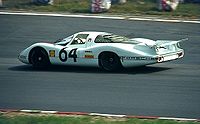Aerodynamics
One of the keys to Le Mans is top speed, caused by the long straights that dominate the circuit. This has meant cars have attempted to achieve the maximum speeds possible instead of relying on downforce for the turns. While early competitors' cars were street cars with their bodywork removed to reduce weight, innovators like Bugatti developed cars which saw the beginnings of aerodynamics. Nicknamed tanks due to their similarity to military tanks of WWI, these cars used simple curves to cover all the mechanical elements of the car and increase top speed. Once Le Mans returned after World War II, most manufacturers would adopt closed bodies which were streamlined for better aerodynamics. A notable example in the changes brought about by aerodynamics are the 1950 entries by Briggs Cunningham. Cunningham entered two 1950 Cadillac Coupe de Villes, one nearly stock and the other completely rebodied in a streamlined aluminum shape developed by aeronautical engineers from Grumman Aircraft Engineering Corporation. The streamlined car looked so unusual that it was nicknamed "Le Monstre" by the French press. The smoothing of body shapes and fairing-in of various parts of the machine brought about by the continual search for reduction of aerodynamic drag led to a separation from Grand Prix cars, which rarely had large bodywork. As the years went on, bodywork becameall enveloping, while at the same time lighter. The larger bodywork with spoilers were able to provide more downforce for the turns without increasing the drag, allowing cars to maintain the high top speeds. Extended bodywork would usu

lly concentrate on the rear of the car, usually being termed long tail. The bodywork also began to cover the cockpit for less drag, although open cockpits would come and go over the years as rules varied. Aerodynamics reached its peak in 1989, before the Mulsanne Straight was modified. During the 1988 race, the crew of a W.M. prototype taped over the engine openings and set a recorded speed of 404 km/h (251 mph) down the Mulsanne in a publicity stunt, although the car was almost undrivable elsewhere on the circuit and the engine was soon destroyed from a lack of cooling. However, for the 1989 event, the Mercedes-Benz C9 reached 399 km/h (248 mph) under qualifying conditions. Automobiles Ettore Bugatti was a French car manufacturer of high-performance automobiles, founded in 1909 in Molsheim, Alsace by Italian-born Ettore Bugatti. Bugatti cars were well known for their design beauty (Ettore Bugatti was from a family of artists and considered himself to be both an artist and constructor) and for the large number of races that they have won. The death of Ettore Bugatti in 1947 proved to be the end for the marque, and the death of his son Jean Bugatti in 1939 ensured there was not a successor to lead the factory. No more than about 8000 cars were made. The company struggled financially, and released one last model in the 1950s, before eventually being purchased for its airplane parts business in the 1960s. In the 1990s, an Italian entrepreneur revived it as a builder of limited production exclusive sports cars. Today, the name is owned by German automobile manufacturing group Volkswagen.